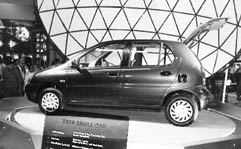Half of diesel
 it was one of the biggest marketing event for vehicles ever organised. And it showed that Indian industry still has to wake up and smell the fumes. In spite of the noise created by the media and environmentalists over the urgency to introduce more fuel-efficient vehicles in India, the international Automobile Exposition 1998 (Auto Expo '98) in New Delhi only had a hollow green slogan to offer: "Small is efficient."
it was one of the biggest marketing event for vehicles ever organised. And it showed that Indian industry still has to wake up and smell the fumes. In spite of the noise created by the media and environmentalists over the urgency to introduce more fuel-efficient vehicles in India, the international Automobile Exposition 1998 (Auto Expo '98) in New Delhi only had a hollow green slogan to offer: "Small is efficient."
Even a cursory survey of the expo indicated that the automobile industry has a wrong notion of eco-friendly vehicles. The entire global scientific debate on the carcinogenic effects of emissions and small particulate matter (spm) from dirty diesel seems to have been ignored by industry leaders. Two themes - 'small' and 'diesel' - dominated the exposition.
Most of the new models ran on diesel. Industry representatives, when asked whether they were aware of the potential health hazard of diesel emissions, showed complete ignorance of the subject. Some even tried to misguide customers when they said that a vehicle met "Euro i norms, which are same as India 2000 norms" for emissions. They failed to point out that Euro i norms were in force in Europe in 1992 and have since been revised twice.
Even more interestingly, a Daewoo spokesperson told a Down To Earth reporter: "Our company is not going in for diesel-run cars. We are very environmentally conscious." A few days later the company announced that it would soon source diesel engines from Renault of France.
All major players in the automotive sector - telco , Maruti Udyog Ltd (mul), the new joint venture of Mitsubishi and Hindustan Motors, Premier Automobiles Ltd (pal), Mercedes-Benz (India), Mahindra Ford, Escorts, Bajaj Auto - were marketing diesel vehicles. The argument: the vehicles offer the consumer the advantage of low running cost. Hindustan Motors (hm) is poised to switch over completely to diesel-fuelled cars. According to the hm marketing representative: "The ratio of the diesel- to petrol-driven vehicles produced by hm at the moment is 70:30."
For sure, the expo showed that manufacturers are targeting an untapped segment of the market to break the monopoly of mul in the small car segment. telco will launch a diesel version of the 1,400 cc model, Indica Mint . pal has brought out a diesel version of the 1,700 cc Fiat Uno. These cars are pitted against the diesel version of mul's Zen that will soon hit the roads.
Moreover, the competition extends to three-wheelers. Bajaj Auto has been in a tizzy ever since Greaves launched Garuda , a diesel-powered three-wheeler, and has launched its own diesel version.
In fact, there is no indication that planners have learnt any lesson about the flaws in their pricing policy for fuel. And the industry has no qualms about a long-term production strategy based on engines that run on diesel. pal market development executive Deepak Sapru was very confident about the company's plans on this front. "Indian politicians, they will never be able to raise the price of diesel to make it at par with petrol prices." Representatives of Bajaj even spelt it out: "We will move back to petrol-run vehicles if the subsidy on diesel is removed."
Talk of the environmental and health hazards of diesel emissions only invited cynicism and irritated people from the auto industry at the exposition.Said one testily: "Why can't you stop bothering and interfering? Let people buy a vehicle which will not burden them with high running costs."
Related Content
- Majority of air pollution deaths in India due to diesel vehicles emission, claims study
- A global snapshot of the air pollution-related health impacts of transportation sector emissions in 2010 and 2015
- The future of trucks: implications for energy and the environment
- Solar rooftop: Replacing diesel generators in residential sectors
- VW emissions cheat may lead to 50 premature deaths, $423 million in economic costs, study shows
- Biofuels policy in Indonesia: overview and status report
